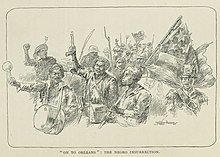This article needs additional citations for verification. (November 2021) |
| 1811 German Coast uprising | |||||||
|---|---|---|---|---|---|---|---|
| Part of the Slave Revolts in North America | |||||||
 | |||||||
| |||||||
| Belligerents | |||||||
| Black slaves |
| ||||||
| Commanders and leaders | |||||||
|
Charles Deslondes |
Wade Hampton I John Shaw William C. C. Claiborne | ||||||
| Strength | |||||||
| 200–500 enslaved Africans and African Americans | 2 companies of volunteer militia, 30 regular troops and 40 seamen | ||||||
| Casualties and losses | |||||||
| 95 total killed from skirmishes and sentencing after trials | 2 killed | ||||||
| Part of a series on |
| North American slave revolts |
|---|
 |
The 1811 German Coast uprising was a slave rebellion which occurred in the Territory of Orleans from January 8–10, 1811. It occurred on the east bank of the Mississippi River in the modern-day Louisiana parishes of St. John the Baptist, St. Charles and Jefferson.[1] The rebellion was the largest of its kind in the history of the United States, but the rebels only killed two white men. Confrontations with U.S. military personnel and local militiamen who were sent to suppress the rebellion, combined with post-trial executions, resulted in the deaths of 95 rebels.
On January 8, between 64 and 125 enslaved people ignited a fight for freedom and marched from plantations in and near present-day LaPlace, Louisiana on the German Coast towards New Orleans.[2] More people escaped slavery and joined them along the way, and some accounts claimed a total of 200 to 500 people escaped and participated in the rebellion.[3] During their two-day, 20 mi (32 km)-long march, the rebels, armed mostly with improvised weapons, burned five plantations along with several sugarhouses and crop fields.[4]
White settlers led by U.S. officials formed militia companies, and in a battle on January 10 killed 40 to 45 of the people escaping slavery while suffering no fatalities themselves, then hunted down and killed several other people without trial. Over the next two weeks, White planters and U.S. officials interrogated, tried, executed, and decapitated an additional 44 people escaping slavery who had been captured. Executions were generally by hanging or firing squad. Heads were displayed on pikes to intimidate others.
Since 1995, the African American History Alliance of Louisiana has led an annual commemoration in January of the uprising, in which they have been joined by some descendants of participants in the revolt.[5]
- ^ Rothman (2005), p. 106.
- ^ Sternberg, Mary Ann (2001). Along the River Road: Past and Present on Louisiana's Historic Byways. Baton Rouge: Louisiana State University Press. p. 12.
- ^ "'American Rising': When Slaves Attacked New Orleans". NPR. January 16, 2011. Retrieved January 16, 2011.
- ^ Genovese, Eugene D. (1976). Roll, Jordan, Roll: The World the Slaves Made. New York: Vintage Books. p. 592.
- ^ Lowen, James W. (2007). Lies Across America: What Our History Sites Get Wrong. New York: Simon & Schuster. p. 192.